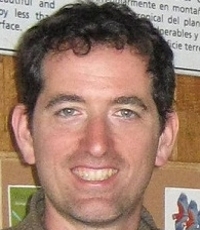Alessandro Catenazzi
Assistant Professor

My current research interests are the systematics and conservation of Neotropical amphibians and reptiles, and the ecological dimensions of biodiversity. For the first line of research, I have worked primarily in Peru, where I lead several research projects in the Andes and the Amazon, and where I participate in rapid field inventories. I collaborate with colleagues in natural history museums and other research institutions in describing new species and developing phylogenies of frogs from the mega-diverse eastern slopes of the Andes. I am interested in using phylogenies as a road map to compare and contrast physiological traits among species, specifically traits related to thermal physiology. As part of these investigations, my collaborators and I are studying thermal preferences, tolerance to heat, and the influence of temperature on physiological functions, in order to understand how climate warming will affect these animals. Finally, a major theme of my current research is exploring the effects of fungal disease on the ecology of amphibians, a group that is experiencing staggering biodiversity losses worldwide. After documenting the collapse of a species-rich amphibian assemblage, I am interested in developing strategies to mitigate the impact of the fungal disease chytridiomycosis on surviving species.
Education
Diploma of Biologist, University of Neuchatel, Switzerland, 1999
PhD, Florida International University, 2006
Courses taught
Conservation Biology (ZOOL 410); Amphibian Seminar (ZOOL 585H); Conservation of Natural Resources (ZOOL 312i)
Areas of interest
My current area of research is amphibian conservation and the role of abiotic and biotic stressors in population declines and extinctions.
Selected Recent Publications
Fey, S.B., A.M. Siepelski, S. Nussle, K. Cervantes-Yoshida, J.L. Hwan, E.R. Huber, M.J. Fey, A. Catenazzi and S.M. Carlson. 2015. Recent shifts in the occurrence, cause, and magnitude of animal mass mortality events. Proceedings of the National Academies of Sciences USA. doi: 10.1073/pnas.1414894112
Catenazzi, A., E. Lehr and V. T. Vredenburg. 2014. Thermal physiology, disease and amphibian declines in the eastern slopes of the Andes. Conservation Biology 28: 509–517.
Catenazzi, A. and R. von May. 2014. Conservation status of amphibians in Peru. Herpetological Monographs 28: 1–23.
Catenazzi, A., R. von May and V. T. Vredenburg. 2013. High prevalence of infection in tadpoles increases vulnerability to fungal pathogen in high-Andean amphibians. Biological Conservation 159: 413–421.
Catenazzi, A., E. Lehr and R. von May. 2013. The amphibians and reptiles of Manu National Park and its buffer zone, Amazon Basin and eastern slopes of the Andes, Peru. Biota Neotropica 13: 269–283.
Kupferberg, S.J, W. Palen, A. Kind, S. Bobzien, A. Catenazzi, J. Drennan and M.E. Power. 2012. Disrupted seasonality in rivers drives reduced survival, population declines, and range-wide losses of California river-breeding frogs. Conservation Biology 26: 513–524.
Catenazzi, A., E. Lehr, L. Rodriguez and V. Vredenburg. 2011. Batrachochytrium dendrobatidis and the collapse of anuran diversity and abundance in the upper Manu National Park, southeastern Peru. Conservation Biology 25: 382–391.
Click here to view my webpage.
